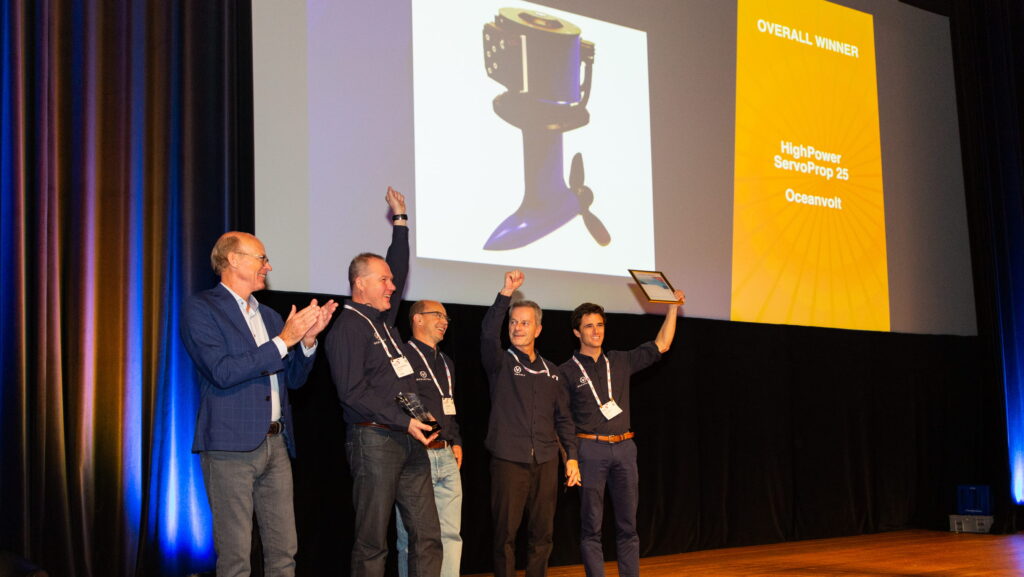
DAME Awards uncovered: behind the scenes of the judging process
In the latest issue of Marine Industry News magazine, editor Chantal Haines talks to DAME Award non-voting secretary Kim Hollamby about the judging process, top submissions and what the panel really looks for in winning products.
Launched in 1991 to promote and recognise the best-designed products at METSTRADE, the DAME Design Awards are some of the most coveted prizes in the leisure marine industry. Products are catapulted into the industry spotlight simply by reaching the awards shortlist and a win can secure significant sales and brand recognition.
Kim Hollamby was a voting jury member from 1996 until 2004, chair of the jury 2005-2006, took a break until 2013 and was then appointed non-voting secretary of the jury and has been in that role ever since. Here, Hollamby reveals some of the secrets of the DAME Awards and what goes into the rigorous judging process.
What makes the DAME Awards unique?
KH | Two aspects are obviously original and not replicated in any other marine competition. Both are important for entrants to understand. Firstly, the Design at METSTRADE Awards, to give it its full name, is not just about the next innovative thing – it is focused more broadly on encouraging excellent end-to-end design practices that make boating more accessible, pleasurable, and sustainable for the industry’s customers.
Good design means something different to everyone you ask. Some think aesthetics and beauty, while others might connect the term with functionality, efficiency, innovation, and other tangible outcomes. Jury members assess the total design in all those aspects.
It’s great to see a completely new concept, of course, and the jury will pay good attention to market-disruptive products. However, the incremental design improvement of equipment that boaters have used for decades is equally valid as a reason for entering.
The second unique facet of the DAME is that the jury meets one month ahead of METSTRADE for two long days of physical inspection of entries after preparing beforehand by studying written submissions and other online materials.
It’s a very hands-on, sleeves-rolled-up meeting that enables jury members to appreciate the design approach of the product and even its important peripherals such as packaging, documents, and presentation.

Oceanvolt’s HighPower ServoProp 25 was the overall winner of the DAME Design Awards at METSTRADE 2023
What do you always look for in a winning product?
KH | The DAME seeks excellent design in all aspects, including styling, construction, functionality, fulfilment of purpose, ease of use, sustainability, originality, innovation, interoperability where applicable, and price versus performance.
Winning products may be flawed in some areas, but the jury will look for the best blend of those disciplines and outstanding examples of any of those aspects. It is rare for anyone to leave the DAME judging meeting without having ‘I want one of those’ moments.
How do you whittle down to a shortlist of nominees?
KH | The first round of judging is critical because this decides the list of nominated products. These are entries where the jury sees obvious design merits worthy of closer scrutiny in later rounds. While winning outright is an understandable focus, gaining the jury’s approval at the nomination level is invaluable.
All nominee products are displayed on the DAME Awards exhibition at METSTRADE, which is consistently highlighted by visitors and exhibitors as a frequently visited feature of the show. In the past ten years, more than 500 products have been nominated and then showcased in this way.
Further rounds decide the Winners and Special Mentions in each category before the final discussion to identify which Category Winner will take the overall DAME Award. The jury also considers whether it has identified an exemplary product for its discretionary Environmental Design Award.

The 2023 DAME jury (Ben Ellison and Elaine Bunting not pictured)
What makes a product stand out?
Most obviously, the product and whether it ticks all the design boxes. Less obviously, a well-prepared entry containing all the critical information the jury needs to know, backed by facts and evidence-based statements and inclusions.
KH | The entry field typically has 100-130 products yearly, a lot for the jury to examine. What you submit in your entry may determine how quickly the judges understand your product. Remember, they are all from qualified technical backgrounds and appreciate facts, not marketing language when assessing products.
What might surprise readers to know about previous years?
KH | If you haven’t followed the DAME Awards, the biggest surprise might be the extreme boundaries of product sizes and complexities for successful entries.
Even at the overall winner level, the DAME has named everything from £15 lifejacket lights and a safety hook to high-end deck equipment, complex marine electronics, propulsion, and other systems.
Another surprise might be the variety of companies nominated. The list contains plenty of big names with large R&D budgets, as expected, but it also includes plenty of startups and small businesses.
Never think your business is too small or your product too simple to be considered.
Why were changes to the categories needed in 2023?
KH | The DAME categories served us well for three decades. However, recent years have seen rapid change in the marine equipment sector and the broader industry. Product development is accelerating under the influences of shifting customer demographics, the push for greater sustainability, increasing levels of integration, and the digitisation of almost everything.
We’d discussed the need to re-evaluate as far back as 2019, but I don’t need to tell you what got in the way the year after. That delay turned out to be beneficial because it provided more time to design the right solution and consider post-pandemic shifts. The changes address new industry priorities and achieve a more even balance across eight categories (up from seven).
We also completely structured the language in the categories to highlight the products’ end-use purpose and where a trade or consumer customer might encounter them. Feedback from last year was positive, so you’ll see the same categories again in 2024 when we open for entries in July.

The DAME Awards are presented at METSTRADE
Any tips on how to win?
KH | 1. Read the terms and conditions carefully. ‘Ts and Cs’ might suggest a dry read full of legal jargon, but it’s more like a guidance document highlighting what the jury needs from you.
2. Look at last year’s jury report. The full list of nominated products is included, and the comments about winners offer some insight into the jury’s thinking.
3. Don’t leave your entry too late. Getting ahead will make for a better entry.
What might surprise readers to know about the judging?
KH | The jury meeting is held these days in DB Schenker’s warehouse at RAI Amsterdam. Given increasingly significant variation in product sizes, it is the most accessible location to bring everything together.
Given the range of professional qualifications and experiences within the jury, the debate is always lively and informative. These well-informed, differing perspectives are a real strength of the DAME.
I’ve been honoured to be associated with this competition as a jury member, chair, and now non-voting secretary but even with that experience I would not place money on a guessed winner at the outset of judging.
Do you ever see a product at a boat show and wish it could be submitted it for the DAME?
KH | Frustratingly, that can happen. The DAME is only open to the 1,600 exhibitors of METSTRADE, so that is a possible cause. Other reasons might include lack of time, difficulty meeting deadlines for submitting products, or a belief that a company might not win. We do what we can to encourage entrants; I’d urge anyone seeking assistance or unsure about any aspect of the DAME to email dame@rai.nl – we’ll do what we can to help.
Images courtesy of METSTRADE / Dame Design Awards.
The post DAME Awards uncovered: behind the scenes of the judging process appeared first on Marine Industry News.
